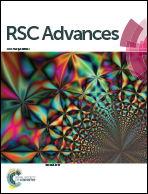Bounded amplification of diffusioosmosis utilizing hydrophobicity†
Abstract
This study is to investigate if and how much surface hydrophobicity can augment diffusioosmotic velocity. Molecular dynamics simulations are utilized to estimate the slip length of diffusioosmosis through slit microducts of different surface conditions. Having the slip length in hand, hydrodynamic analyses based on the Navier slip conditions are performed to derive semi-analytical solutions of the locally developed velocity field. It is shown that, unlike electroosmosis, there is an upper limit for diffusioosmotic flow enhancement by means of hydrophobic surfaces: only about 1 order of magnitude amplification of the flow rate is achievable. This is attributed to the decreasing dependency of the velocity gradient at the wall and the electric field on the slip length for diffusioosmosis, even though the latter is very weak. Moreover, we demonstrate that hydrophobicity is more effective at low zeta potentials; based on this fact, full analytical solutions are presented for the velocity field invoking the Debye–Hückel linearization. The slip effects are intensified when the diffusivity of the counterions increases. Furthermore, slippage increases the chance of flow toward higher concentrations, revealing that hydrophobicity not only is a tool to increase the flow rate, but also may be utilized as a mechanism for diffusioosmotic flow control.


 Please wait while we load your content...
Please wait while we load your content...